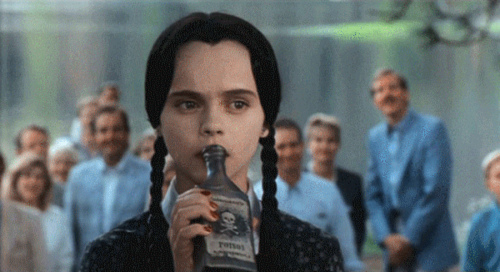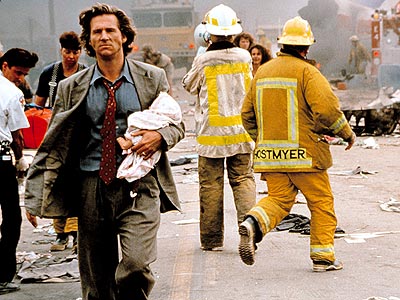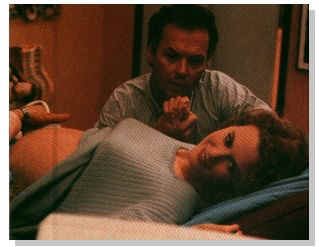From the Chicago Reader (November 26, 1993). — J.R.
DEMOLITION MAN
* (Has redeeming facet)
Directed by Marco Brambilla
Written by Daniel Waters, Robert Reneau, and Peter M. Lenkov
With Sylvester Stallone, Wesley Snipes, Sandra Bullock, and Nigel Hawthorne.
FEARLESS
* (Has redeeming facet)
Directed by Peter Weir
Written by Rafael Yglesias
With Jeff Bridges, Isabella Rossellini, Rosie Perez, Tom Hulce, and John Turturro.
MY LIFE
** (Worth seeing)
Directed and written by Bruce Joel Rubin
With Michael Keaton, Nicole Kidman, Bradley Whitford, Queen Latifah, Michael Constantine, and Haing S. Ngor.
With the steady rise of committee moviemaking and the steady shrinking of attention spans thanks to TV, suspension of disbelief and densely imagined fictional worlds are becoming scarce commodities in pop movies. A relative triumph of style and blackout wit like Addams Family Values reflects this loss just as much as an airhead, cyberdolt, kick-ass romp like Demolition Man. In both films a character’s behavior or personality — and sometimes even the physical terrain — can change radically from one scene to the next, and no one in the audience is expected to notice or even care.

The only thing that seems to be important is that the scene (or moment) score. Wednesday Addams can easily turn from being romantic and gentle toward a nerdy fellow camper to being sadistic enough to want to scare him to death — a transformation easily accepted in two Charles Addams cartoons appearing weeks or months apart in the New Yorker, where such reinventions were to be expected. The shift is a bit stranger when the same actress is playing both Wednesdays in the same movie with the same story line and no reason for any change of heart is apparent.
Similarly, after Demolition Man goes to the trouble of “establishing” the 2032 California city of San Angeles (which physically resembles Albert Brooks’s spiffy west-coast purgatory in Defending Your Life), where crime and violence have become virtually extinct, it doesn’t think twice about violating this condition for the sake of a passing gag. A 1996 cop (Sylvester Stallone), once frozen and now thawed, casually tests out a futuristic gun by zapping a random pedestrian, and nobody in the immediate vicinity even raises an eyebrow. Later, when a subsequent scene requires the San Angeleans to be tender souls again, the movie doesn’t hesitate to switch them back, having them visibly recoil from less violent provocations.
Unlike Addams Family Values, Demolition Man can’t be said to derive literally from cartoons, though there are times when its basic premises seem to come straight out of Andrew Dice Clay stand-up routines — and not just because one of its principal screenwriters, Daniel Waters, worked on The Adventures of Ford Fairlane. Consider the ingredients: a ghetto criminal with blond hair named Simon Phoenix (Wesley Snipes), who likes to kill people for the fun of it; muscle-bound “demolition man” John Spartan (Stallone), an LA police sergeant hunting Phoenix with equal abandon; a future America that has outlawed salt, meat, cigarettes, cuss words, violence, sexual intercourse, and Playboy (which still exists or doesn’t, depending on the scene). They’re all part of a kvetching Clay premise diced into gags aimed at exploiting an audience’s petty irritations without any thought being entertained.
Nobody bothers to string this all together into a consistent satire, and nobody in the audience seems to expect anyone to: as long as lots of plate glass breaks and buildings explode, even a sustained sense of who the good and bad guys are and why seems like a literary luxury, a holdover from the days of Gene Autry. Phoenix and Spartan can go from being smart to dumb, anarchic to organized, motivated to unmotivated; Spartan’s police partner Lenina Huxley (Sandra Bullock) can swing from being nauseated by the mere mention of kissing to being stirred and satisfied by an actual kiss a few hours later. No commercial breaks currently appear between the two scenes with Huxley — though the movie isn’t coy about plugging Marlboro and Taco Bell — but the audience doesn’t seem to mind that they’re disconnected.
As a consequence, a movie like Demolition Man — unlike, say, Forbidden Planet or Blade Runner or Defending Your Life — isn’t somewhere you can pitch a tent. With the characters and plot premises as collapsible as the buildings, the ephemeral enjoyment to be found here is strictly televisual: the film is an SF romp with built-in channel surfing.
Turning from Hollywood light entertainment to Hollywood deepthink in Fearless (not running this week, but sure to return to second-run theaters), you’d expect something firmer in the way of a fictional world, and up to a point you get it. Still, the fictional world here is less substantial, less believable than what you could have found ten years ago in roughly comparable efforts, e.g., Shoot the Moon or Terms of Endearment. Indeed, if you try to imagine more of this world than you see and hear in the film, you’re likely to find yourself, like the hero at one point, running straight into a brick wall.
After surviving a cataclysmic airplane crash in California in which his business partner is killed, and heroically leading other passengers to safety, a San Francisco architect named Max (Jeff Bridges) returns to his wife (Isabella Rossellini) and young son a profoundly changed man — oddly euphoric and seemingly fearless, yet remote from and indifferent to the needs of his family. The only person he can establish some feeling of intimacy with and concern for is another survivor of the crash, a grief-stricken young housewife named Carla (Rosie Perez) who lost her baby in it.
In setting up the rudiments of this situation, the film can’t be faulted, at least on the level of its script (Rafael Yglesias adapting his own novel), direction (Peter Weir returning to a relatively serious mode after the claptrap of Dead Poets Society and Green Card), and performances (Bridges and Perez give uncharacteristic, highly arresting portraits of people in a sustained state of shock). The film periodically flashes back to the crash and various incidents on the plane immediately preceding it, and these scenes are persuasively shown (though the arty, silent depiction of the crash itself seems a little forced).
But as soon as I try to imagine Max working at his job and living with his family before the accident, I draw an utter blank. For all practical purposes, the preaccident Max can’t be said to exist — even though other characters, most notably his wife, constantly allude to him in the past as if he did. We’re told various things about his past, but are given no concrete evidence of who he was. And slowly but surely, this void undermines everything else in the film that the script, the actors, and the direction have taken such pains to establish.
If I try to pinpoint what’s responsible for this failure, the apparent necessity of each scene to make an immediate impression — rather than, say, an intermediate one building a sense of the everyday that would yield something more durable — seems a significant part of the problem. This can be described as a problem originally inscribed in the reflexes of TV executives, whose cardinal rule appears to be: avoid making the viewer want to switch channels at all costs. Arguably, this was part of Weir’s directorial style even before it became part of the international mainstream — in his gripping work in The Last Wave (1977), for instance, which is recalled in some of the early hallucinatory moments depicting Max in his postaccident mode.
The result is that Max’s supposedly aberrant behavior is denied a measuring stick — some sense of what his “normal” behavior consisted of (apart from being allergic to strawberries). This lack of information helps pique our curiosity about him at the beginning, when we can’t be sure whether he’s a visionary or simply off his rocker; but by the end we don’t have any better idea of who he is. Worse, we aren’t persuaded that the filmmakers know either. His lawyer (Tom Hulce), also employed by his former partner’s widow, is shown as a cartoonish money grubber, and a posttraumatic-stress therapist (John Turturro) assigned to him and Carla by the airline is made to seem alternately naive and earnestly conscientious. Both these characters might have helped us know who Max was and is by clarifying who he’s not, but they only clarify a few things about Max in the present: he doesn’t care about money, he isn’t looking for therapy. How much he cared about money and whether he might have needed therapy before the accident aren’t the sort of questions the film bothers to address. And thanks to this lack of curiosity, the character’s reality and our concern about his fate steadily diminishes.
No such lack of substance can be found in My Life — another new movie about what happens to someone facing his own death, this one the directorial debut of Bruce Joel Rubin, who wrote the scripts for Brainstorm, Jacob’s Ladder, and Ghost. For all my appreciation of Jacob’s Ladder, I sort of gritted my teeth at the prospect of getting more lessons in Rubin’s new-age spirituality. And judging from the sparse attendance in the Biograph’s main auditorium at a Saturday matinee, I suspect that the received wisdom that a movie about actual death (as opposed to play death in bloody bashfests like Demolition Man) is box-office poison may be true, with or without new-age spirituality.
Nevertheless, the movie is a lot more believable and satisfying than either Demolition Man or Fearless, at least on the level of establishing a fictional world that remains reasonably solid for the length of a feature. Admittedly its premise, which the film never deviates from, is relatively simple: A successful Los Angeles businessman in public relations named Bob Jones (Michael Keaton), whose wife Gail (Nicole Kidman) has just become pregnant with their first child, discovers he has incurable cancer and only a few months to live. Hopeful but not confident that he’ll live long enough to see his child, he decides to make a self-portrait video as a legacy, and as a consequence sets about putting his emotional and spiritual house in order.
My Life can’t be said to share any of the plausibility problems cited above. We get some notion of who Jones was before as well as after he receives his death notice, and his character retains some consistency from one scene to the next. The film can’t be said to have much complexity, but it certainly stays true to its agenda, and its sincerity — to which Keaton and Kidman both contribute generously — is never in question.
Where the film flouts believability is in a more old-fashioned, time-tested, and Hollywoodish way: Jones has such wonderful, blissful good fortune in getting ready for death that he makes it seem like a vacation in the Bahamas. (In keeping with Rubin’s new-age sensibility, the pivotal guru in this process is a Chinese doctor, played by Haing S. Ngor — a vast improvement on Keye Luke’s Dr. Yang in Woody Allen’s Alice, in that he resembles a human being and speaks common sense.) If you’ve had a life this fabulous, the viewer is encouraged to conclude, why not get out while the getting’s good rather than wait for it all to sour? The movie is far from facing down cruel and harsh truths, registering more often as fantasy wish fulfillment, and much of it plays as light comedy.
Even before he gets the bad news, Bob is a prosperous businessman with a beautiful, loving, and admiring wife, a comfortable home, and no apparent financial worries or career frustrations — just a poor Ukrainian family back in Detroit that he avoids, including a father who resents him for changing his last name from Ivanovich to Jones, and a fear of riding roller coasters. Both these nagging problems, as well as his fear of dying before his child is born, are efficiently licked before the movie’s over.
The problem with this best-case-scenario movie is not so much whether we believe in it or accept the death theme, as it is staying interested in a plot in which narrative suspense is kept to a minimum. It’s certainly nice to see Rubin doing without the squandering, everything-for-the-moment tactics of Demolition Man and Fearless, which leave only noncharacters and nonstories in their wake, though there are times when this movie could use a little of the speed and pizzazz of the other two.







